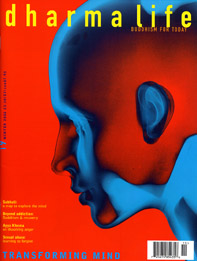Sublime Salvage
Vajrasara reports on a stunning exhibition of Chinese Buddhist sculpture.
A simile in the Tathagatagarbha Sutra, an influential text in Chinese Buddhism, tells how a man transporting a golden statue wraps it in dirty rags to protect it from marauders. Then he dies and the statue is discarded in an unused field. Travellers trample over it and it becomes wholly sunk in the mud. Later someone who sees things clearly alerts people to the presence of the treasure, and the precious statue is brought to light.
The Sutra's simile is an image of human beings' innate spiritual potential; it is also uncannily reminiscent of the statues in last summer's exhibition 'The Return of the Buddha' at London's Royal Academy of Arts. The 1500-year-old sculptures, which are of extraordinary quality and refinement, were discovered near Qingzhou in eastern China. Six years ago workmen clearing land for a playing-field unearthed a hoard of more than 400 statues on a site where a temple had once stood. The sculptures' history is intriguingly uncertain, but it was clear that they had been ritually laid in a pit. It is thought that monks stowed them for posterity – possibly to save them from unsympathetic Confucians.
Mainly standing Buddhas and Bodhisattvas, and often with broken arms, the elegant limestone figures are in remarkably good repair. The original gilding on their bodies and rich colours of their robes and adornments is occasionally visible. Best of all are their beatific faces, which show a range of expressions from half-smiles of contentment to beams of joy, and even chuckles.
Each week teachers from the London Buddhist Centre introduced visitors to ancient Buddhist meditation practices – the Mindfulness of Breathing and Metta Bhavana (development of loving-kindness). Meditating amid the exquisite figures, illumined in the spacious, darkened galleries, fostered a benign and serene atmosphere.
All the meditation sessions were fully booked, which suggests a burgeoning enthusiasm for a taste of the Buddha's wisdom. And no doubt it has drawn to the Dharma a broader selection of people than those who would consider visiting a Buddhist centre. As for the teachers, many said they found it uplifting – even a privilege – to teach surrounded by works of such beauty.



